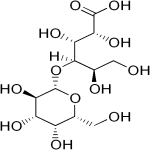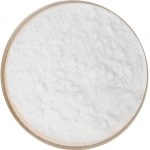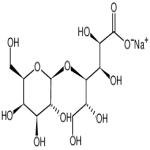Lactobionic Acid USP NF BP Ph Eur & Sodium Lactobionate Suppliers Exporters, Manufacturers
Lactobionic Acid
CAS Number: 96-82-2, USP NF BP Ph Eur Suppliers Exporters, Manufacturers

Please visit Safety Data Sheet of Lactobionic Acid Manufacturers.
Specifications of Lactobionic Acid USP NF Grade:
C12H22O12 (acid form) --- 358.30 --- CAS 96-82-2.
C12H20O11 (δ-lactone) 340.28 CAS 5965-65-1
4-O-β-Galactopyranosyl-d-gluconic acid.
DEFINITION
Lactobionic Acid is a mixture in variable proportions of 4-O-β-d-galactopyranosyl-d-gluconic acid and 4-O-β-d-galactopyranosyl-d-glucono-1,5-lactone. It contains 98% toT 102%, on the anhydrous basis.
IDENTIFICATION
A. Infrared Absorption: [Note: If the spectra obtained show differences, dissolve the test substance and USP Lactobionic Acid RS separately in water, dry at 105C, and record new spectra using the residues. ]
B. Thin-Layer Chromatography: Acceptance criteria:The principal spot from the Sample solution is similar in position and color to the principal spot from the Standard solution.
ASSAY
Acceptance criteria: 98.0%–102.0% on the anhydrous basis
Acceptance criteria: 5.0% maximum.
Appearance of Solution
Sample solution: 120 mg/mL of Lactobionic Acid
Standard stock solution: Pipet 24.0 mL of ferric chloride CS and 6.0 mL of cobaltous chloride into a 100-mL volumetric flask. Dilute with 1% (w/v) hydrochloric acid to volume.
Reference solution: Pipet 12.5 mL of the Standard stock solution into a 100-mL volumetric flask. Dilute with 1% (w/v) hydrochloric acid to volume.
Acceptance criteria: The Sample solution is clear and not more intensely colored than the Reference solution.
Optical Rotation
Sample solution: 10 mg/mL of Lactobionic Acid. Allow to stand for 24 h.
Acceptance criteria: +23.0° to +29.0° (anhydrous substance).
Reducing Sugars
Sample solution: Dissolve 5.0 g of Lactobionic Acid in 25 mL of water with the aid of gentle heat, and cool.
Analysis: To the Sample solution add 20 mL of cupric citrate TS and a few glass beads. Heat so that boiling begins after 4 min, and maintain boiling for 3 min. Cool rapidly, and add 100 mL of a 2.4% solution of glacial acetic acid and 20.0 mL of 0.025 M iodine VS. With continuous shaking, add 25 mL of a mixture of 6 mL of hydrochloric acid and 94 mL of water. When the precipitate has dissolved, titrate the excess iodine with 0.05 M sodium thiosulfate VS using 1 mL of starch TS, added toward the end of the titration as an indicator.
Acceptance criteria: NLT 12.8 mL of 0.05 M sodium thiosulfate is required, corresponding to NMT 0.2% of reducing sugars, as glucose.
Articles of Botanical Origin: 0.2% maximum.
Specifications of Lactobionic Acid BP Ph Eur Grade
Ph Eur
C12H22O12 (acid form) -- 358.3 -- CAS 96-82-2
C12H20O11 (d-lactone) -- 340.3 -- CAS 5965-65-1
DEFINITION
Mixture in variable proportions of 4-O-b-D-galactopyranosyl-D-gluconic acid and 4-O-b-Dgalactopyranosyl-D-glucono-1,5-lactone.
Content: 98.0 per cent to 102.0 per cent (anhydrous substance).
CHARACTERS
Appearance: White or almost white powder.
Solubility: Freely soluble in water, slightly soluble in glacial acetic acid, in anhydrous ethanol and in methanol.
mp: About 125C with decomposition.
IDENTIFICATION
A. Infrared absorption spectrophotometry.
If the spectra obtained show differences, dissolve the substance to be examined and the reference substance separately in water, dry at 105C and record new spectra using the residues.
B. Thin-layer chromatography.
Test solution: Dissolve 10 mg of the substance to be examined in water and dilute to 1 ml with the same solvent.
Reference solution: Dissolve 10 mg of lactobionic acid CRS in water and dilute to 1 ml with the same solvent.
Plate TLC silica gel plate.
Mobile phase concentrated ammonia, ethyl acetate, water, methanol.
Application: 5 μl.
Development: Over 3/4 of the plate.
Detection: Spray 3 times with ammonium molybdate solution and heat in an oven at 110C for 15 min.
Results: The principal spot in the chromatogram obtained with the test solution is similar in position and colour to the principal spot in the chromatogram obtained with the reference solution.
TESTS
Appearance of solution: The solution is clear and not more intensely coloured than reference.
Specific optical rotation: + 23.0 to + 29.0 (anhydrous substance).
Dissolve 1.0 g in 80 ml of water and dilute to 100.0 ml with the same solvent. Allow to stand for 24 h.
Reducing sugars: Maximum 0.2 per cent, calculated as glucose.
Dissolve 5.0 g in 25 ml of water  with the aid of gentle heat. Cool and add 20 ml of cupricitric solution and a few glass beads. Heat so that boiling begins after 4 min and maintain boiling for 3 min. Cool rapidly and add 100 ml of a 2.4 per cent V/V solution of glacial acetic acid and 20.0 ml of 0.025 M iodine. With continuous shaking, add 25 ml of a mixture of 6 volumes of hydrochloric acid and 94 volumes of water and, when the precipitate has dissolved, titrate the excess of iodine with 0.05 M sodium thiosulphate using 1 ml of starch solution, added towards the end of the titration, as indicator. Not less than 12.8 ml of 0.05 M sodium thiosulphate is required.
Heavy metals: Maximum 20 ppm.
Water: Maximum 5.0 per cent, determined on 0.50 g.
Total ash: Maximum 0.2 per cent.

Please visit Hazard Statement of Lactobionic Acid USP NF BP Ph Eur Manufacturers.
Sodium Lactobionate
CAS Number: 27297-39-8, Suppliers Exporters, Manufacturers

Please visit Safety Data Sheet of Sodium Lactobionate Manufacturers.
General Properties and Specifications of Sodium lactobionate or Lactobionic acid sodium salt:
Description: White to pale yellow crystalline powder.
Assay: 98% to 102%
Loss on Drying: 1% maximum.
Heavy Metals: 0.003% maximum.
Storage Temperature: +20C. Shipping may be ambient.

Please visit Hazard Statement of Sodium Lactobionate Manufacturers.
Lactobionic Acid USP NF BP Ph Eur CAS Number 96-82-2 & Sodium Lactobionate CAS Number 27297-39-8 Supplier Exporter, Manufacturer:
Annie Chemie P Ltd
Mumbai 4000010, INDIA
With Agents and offices in UAE, USA, Europe.
e-mail: info@anniechemie.com
Copyright and Usual Disclaimer is Applicable.
May 31, 2025
Exporters to USA, Canada, UK, Europe, UAE, Nigeria, Algeria, Turkey, Mexico, Brazil, Chile, Argentina, Australia, Dubai etc.
Perfection is made up of small things and that is a big thing.
